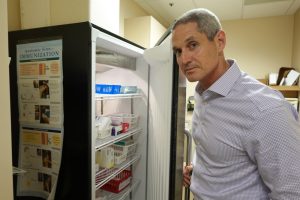Anya Sostek | Pittsburgh Post-Gazette (TNS)
In the late 1980s, Linda Rose Frank began working with HIV-positive individuals at the University of Pittsburgh. At the time, those affected were mainly young men with a terrifying prognosis.
“There was not really anything to treat people,” she said. “We were watching people die.”
More than three decades later, Frank still works at the University of Pittsburgh in the care of those living with HIV. But now, the majority of HIV-positive people are over the age of 50 — and one focus of Frank’s work is how to best care for people aging with human immunodeficiency virus.
Frank is executive director and principal investigator of the MidAtlantic AIDS Education and Training Center. In the last few years, MAAETC has developed training materials specifically focusing on HIV and aging, such as a pocket training guide on “integrating geriatric principles in the HIV clinic.”
“Sometimes it’s difficult to ascertain whether or not what we are seeing is something related to HIV or a normal aging condition,” said Frank. “That requires a lot of assessment by experts.”
The Centers for Disease Control estimates that for its most recent year of data, 2022, there were about 596,000 people over the age of 50 living with HIV — about 53% of the total number. And while most of those people were diagnosed prior to turning 50, more than 2,600 people over the age of 55 were newly diagnosed with HIV that year.
“I think that people assume that older folks don’t engage in sexual relationships, but of course we know that’s not true,” said Frank, who is also a professor in the department of infectious disease at the University of Pittsburgh, as well as Pitt’s nursing and medical schools. “Or that we assume that it’s only young people who use substances — that’s also not true.”
Frank advocates for routine testing for HIV by primary care physicians regardless of age or risk factors. “Just like you need to know your blood pressure and cholesterol, you need to know your HIV status,” she said. “That’s the way to normalize it for everybody.”
Knowledge of HIV status is so important because medications and treatment are so effective, she said. One study last year in Lancet HIV found that for many patients who started their HIV drug regiments after 2015, life expectancy is similar to that of the non-HIV positive population.
Related Articles
Abortion rights questions are on ballots in 9 states. Will they tilt elections?
Fentanyl vaccine heads for clinical trials, with goal of saving lives
America is trying to fix its maternal mortality crisis with federal, state and local programs
Matthew Perry case: Trial set for alleged ‘Ketamine Queen,’ California doctor
Bat in Santa Cruz County tests positive for rabies
One key to long-term health in HIV-positive individuals is ongoing monitoring, said Frank, and that can become even more important in the aging population.
“One of our concerns is that people get lost to care,” said Frank. “For somebody over 50, maybe their husband or wife died and they became depressed — sometimes they’ll drop out of care. Our goal is to do more research to find the people who dropped out of care and get them back in.”
Medication interactions also have to be carefully reviewed in an aging population, as do mental health and mobility concerns. These issues will only intensify as the population continues to age. For its most recent demographic report, the CDC added a “75 and above” category to its age tables. And one estimate predicts that by 2030, 70% of people with HIV will be older than 50.
“They got diagnosed and got treatment,” said Frank, “and now they are living to 50, 60, 70 and above.”
(c)2024 the Pittsburgh Post-Gazette. Visit the Pittsburgh Post-Gazette at www.post-gazette.com. Distributed by Tribune Content Agency, LLC.












